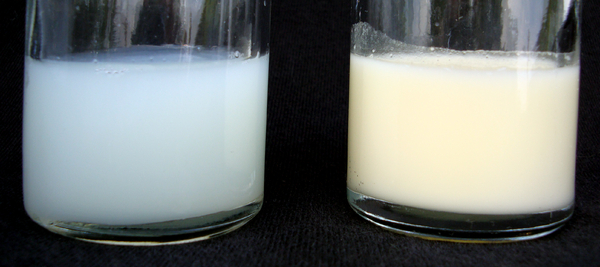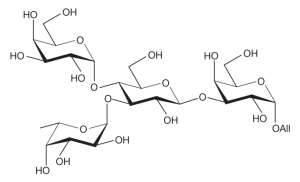Were you aware that the thousands of bacteria residing in our gastrointestinal tract (gut) and their interactions with the dietary foods we consume actually have a great impact on human health?

Two 25-milliliter samples of human breast milk. Source: Wikipedia Commons
Inspired by this discovery, a team of researchers led by Jeffrey Gordon from the Washington University School of Medicine in St.Louis found that the interactions of gut bacteria with the sugars in breast milk promote healthy infant growth.
Why is healthy infant growth a topic of discussion?
Every year, childhood malnutrition causes over 3 million deaths, leads to stunted growth and is associated with impaired cognitive ability.

Branched Oligosaccharide Structure. Source: Wikipedia Commons
In Malawai, Africa, almost 50% of children under the age of 5 showed stunted growth. The researchers collected samples of human breast milk from those mothers with healthy babies or stunted babies. They discovered that the amount of oligosaccharides (sugar) in the breast milk containing sialic acid, an essential nutrient for brain development and cognition, were much greater in the mothers with healthy, relative to stunted growth babies.
This finding suggests that the sugars in the breast milk contribute to healthy infant growth. To analyze whether this was the case, the researchers created animal models, ensuring that both the bacteria in the gut and the diet could be manipulated. Gordon and his team began by isolating bacterial strains from fecal matter of the undernourished babies and inserted it into mice or piglets. Then, the researchers fed the mice or the piglets a typical Malawian diet, consisting of legumes, corn, vegetables, and fruit, a diet itself which is insufficient for healthy growth.

Whey, a by-product of cheesemaking. Source: Wikipedia Commons
With the mice and the piglets mimicking the undernourished Malawian infants, Gordon and his team then began testing effects of the sialic acid-containing sugars. They used cow milk as an alternative because of the difficulty to purify large amounts of sugars from human breast milk. They were able to obtain sialic acid-containing sugars from whey, a by-product of cheesemaking, and fed it to the animals. The mice and piglets showed significant improvements in growth, in both muscle mass and in bone volume. The mice and piglets also showed improved brain development and metabolic activities in the liver.
Because the bacteria in the gut was allowed to be manipulated, the researchers were able to pinpoint which bacterial strains were affected by sialic acid-containing sugars and how the different strains interacted with one another. They found that one strain of bacteria fed on the sialic acid-containing sugars and another strain fed on the digested products of sialic acid-containing sugars. This revealed a possible food web within the bacterial gut community.These two strains of bacteria alone were not sufficient enough to explain healthy growth in the mice and piglets, signifying that more complex interactions among different bacteria in the gut were necessary for growth.
The results of their study were recently published in Cell and serves as the foundation for future studies on the benefits of the components of breast milk on healthy infant growth and its interaction with gut bacteria.
Posted on February 22, 2016 By Jenny U
